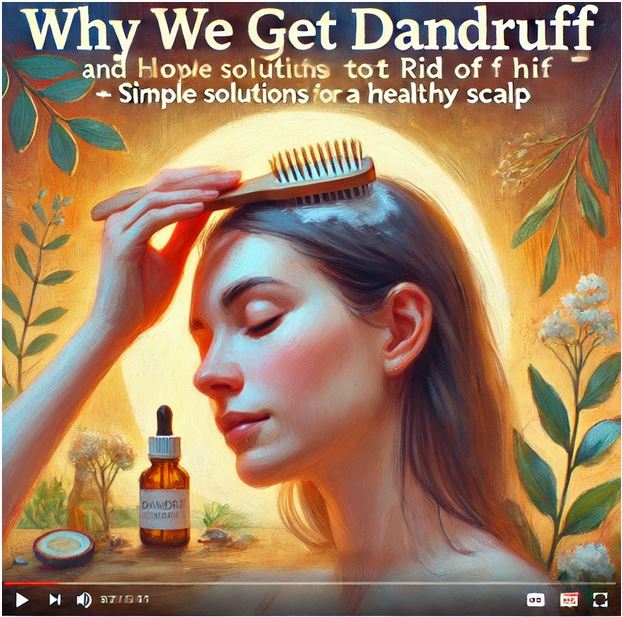Your Cart is Empty
Why We Get Dandruff (and How to Get Rid of It) | Simple Solutions for a Healthy Scalp
22 Jan, 2025 76939

Why We Get Dandruff (and How to Get Rid of It)
Introduction
Dandruff is one of those annoyances that many of us face at some point in our lives. It’s not life-threatening, but it’s certainly frustrating. White flakes on your shoulders, an itchy scalp, and the embarrassment that sometimes comes with it—these are the hallmarks of a condition that’s as common as it is misunderstood.
But what exactly is dandruff? Why does it happen? And, most importantly, how can you get rid of it? To answer these questions, we’ll delve deep into the science of dandruff, explore its causes, and provide practical, science-backed solutions. By the end of this article, you’ll have a clear understanding of this condition and a roadmap to a flake-free life.
Chapter 1: What is Dandruff?
The Science of Skin Renewal
Our skin is constantly renewing itself. On a microscopic level, new skin cells are produced in the lower layers of the epidermis and gradually make their way to the surface. Once they reach the outermost layer, these cells die and are shed. This process is entirely natural and happens all over our body, including the scalp.
Dandruff Defined
Dandruff occurs when this natural shedding process is disrupted. Instead of shedding imperceptibly small flakes, the skin on the scalp sheds larger, visible clumps of dead skin cells. This disruption is often accompanied by itchiness, redness, and sometimes inflammation.
Dandruff can vary in severity. For some, it’s a mild nuisance, while for others, it can be a chronic condition that requires ongoing management.
Chapter 2: Why Do We Get Dandruff?
A Perfect Storm: The Main Culprits
Dandruff arises due to a combination of factors, including:
-
Malassezia Yeast Overgrowth
-
Malassezia is a genus of yeast that lives on the scalp of most people. It feeds on the natural oils (sebum) produced by your scalp. When this yeast proliferates excessively, it can irritate the skin and accelerate cell turnover, leading to dandruff.
-
-
Seborrheic Dermatitis
-
This is a common skin condition that causes red, scaly, and itchy skin. It often affects areas rich in oil glands, such as the scalp, face, and upper chest. Dandruff is essentially a mild form of seborrheic dermatitis.
-
-
Dry Skin
-
Dry skin is a common cause of dandruff, especially in winter when indoor heating can strip moisture from the air and, consequently, your skin. Unlike dandruff caused by Malassezia, flakes from dry skin are usually smaller and less oily.
-
-
Sensitivity to Hair Products
-
Some people develop contact dermatitis, a type of skin irritation caused by certain shampoos, conditioners, or styling products. This irritation can lead to dandruff-like symptoms.
-
-
Other Factors
-
Stress: Chronic stress can weaken the immune system, making it harder for your body to regulate the growth of Malassezia.
-
Diet: A lack of essential nutrients, such as zinc, B vitamins, and omega-3 fatty acids, can contribute to scalp issues.
-
Hormonal Changes: Hormonal fluctuations, such as those during puberty or pregnancy, can increase sebum production, providing a fertile environment for Malassezia.
-
Chapter 3: Myths About Dandruff
Dandruff is one of those conditions shrouded in misinformation. Let’s debunk some common myths:
Myth 1:Dandruffis Caused by Poor Hygiene
While infrequent washing can lead to a buildup of oil and dead skin cells, dandruff isn’t a direct result of poor hygiene. Even those who wash their hair regularly can experience dandruff due to other factors.
Myth 2: Dandruffis Contagious
You can’t "catch" dandruff from someone else. The yeast Malassezia is a natural part of the scalp’s microbiome and is present in almost everyone.
Myth 3: You Should Stop Using Shampoo If You Have Dandruff
On the contrary, washing your hair regularly with the right shampoo can help manage dandruff by reducing oiliness and controlling yeast growth.
Myth 4:DandruffOnly Affects Adults
Although it’s more common after puberty due to hormonal changes, dandruff can also affect babies (cradle cap).
Chapter 4: How to Get Rid of Dandruff
Step 1: Choose the Right Shampoo
The cornerstone of dandruff treatment is the use of medicated shampoos. Look for ingredients such as:
-
Pyrithione Zinc: An antifungal agent that reduces yeast levels.
-
Ketoconazole: A powerful antifungal that targets Malassezia.
-
Selenium Sulfide: Slows down skin cell turnover and reduces yeast.
-
Salicylic Acid: Helps remove dead skin cells and scales.
-
Coal Tar: Slows the production of skin cells.
Step 2: Optimize Your Washing Routine
-
Use a medicated shampoo 2-3 times a week or as directed.
-
Massage the shampoo into your scalp and let it sit for 5 minutes before rinsing.
-
Alternate with a mild, non-medicated shampoo to avoid over-drying.
Step 3: Maintain Scalp Health
-
Hydrate: Use a lightweight, non-comedogenic moisturizer or scalp serum if dryness persists.
-
Exfoliate: Use scalp scrubs or brushes to remove flakes and stimulate circulation.
-
Protect: Avoid overusing heat-styling tools, which can dry out the scalp.
Chapter 5: Natural Remedies
For those who prefer natural approaches, consider these options:
-
Tea Tree Oil
-
Known for its antifungal properties, tea tree oil can help reduce Malassezia levels. Add a few drops to your regular shampoo or use a product formulated with this ingredient.
-
-
Aloe Vera
-
Aloe vera soothes itching and inflammation. Apply aloe vera gel directly to your scalp for relief.
-
-
Apple Cider Vinegar
-
ACV can help balance the scalp’s pH and reduce yeast growth. Dilute it with water (1:1 ratio) and use it as a rinse.
-
-
Coconut Oil
-
Coconut oil’s moisturizing properties can help combat dryness. Massage it into your scalp and leave it on overnight before washing.
-
-
Baking Soda
-
Acts as a gentle exfoliant. Mix it with water to create a paste and apply it to your scalp.
-
Chapter 6: Long-Term Management
Lifestyle Adjustments
-
Diet: Include foods rich in zinc, omega-3s, and B vitamins to support scalp health.
-
Stress Management: Practice relaxation techniques like meditation, yoga, or deep breathing.
-
Hydration: Drink plenty of water to keep your skin hydrated.
When to See a Dermatologist
If your dandruff persists despite trying over-the-counter remedies, or if it’s accompanied by severe redness, swelling, or hair loss, consult a dermatologist. They may prescribe stronger treatments or identify underlying conditions.
Conclusion
Dandruff might be a common issue, but it doesn’t have to be a constant struggle. By understanding its causes and implementing effective treatments, you can take control of your scalp health. Whether you opt for medicated shampoos, natural remedies, or lifestyle changes, the key is consistency and patience. So, say goodbye to flakes and hello to confidence—your scalp will thank you for it.




